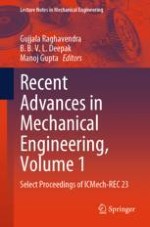This book presents select proceedings of International Conference on Mechanical Engineering: Researches and Evolutionary Challenges (ICMech-REC 23). It covers the latest research in the areas of mechanical engineering and materials applications. Various topics covered in this book are materials (composite, nano-, advanced), design methodologies, Industry 4.0, smart manufacturing, thermodynamics, mechatronics, robotics, soft computing, and automation. The contents of this book are useful to the researchers and professionals working in the different areas of mechanical engineering.
